The Best 5 Social Engagement Strategies Used by Top Influencers
The Best Strategies to Increase Your Social Media Engagement
In the world of digital marketing, social media is king. Businesses and individuals alike are using social media platforms to connect with audiences worldwide more than ever before. And the art of social engagement is a crucial component of social media success. Engaging with your audience builds trust, encourages loyalty, and boosts your bottom line. Even more, by increasing your social media engagement, you also improve your branding, sales, and recognition.
In this blog post, we’ll explore five social strategies used by top influencers to increase their engagement. These strategies have helped influencers build massive followings and generate significant revenue. By following these strategies, you can harness social media engagement’s power and grow your business.
The five strategies are:
Triggers: Use triggers to get your audience’s attention. This could be anything from a timely post to a catchy hashtag.
Social Sharing: Encourage your audience to share your content with their own followers. This is a great way to reach a wider audience and increase engagement.
Emotions: Tap into your audience’s emotions to create content they will connect with. This could be anything from humor to inspiration.
Usefulness: Create content that is useful and informative for your audience. This will make them more likely to engage with your content and keep returning for more.
Share or Make Public: Give your audience the option to share or make your content public. This will help you reach a wider audience and generate more engagement.
Following these strategies can improve your social media engagement and grow your business.
The Best 5 Engagement Strategies Used By Famous Influencers
1.Triggers
A trigger is something that brings about a response or reaction. As such, a statement, an occurrence, or a circumstance might cause someone to act or feel in a certain way. Triggers are the best way to increase social engagement with followers. Similar to buttons, triggers cause something to happen when they are pressed. They have the power to elicit specific feelings, thoughts, or actions from us. Triggers can be both good and bad. For example, a hilarious joke can make us laugh, while a painful memory can make us cry. On the other hand, triggers are used in the context of engagement to catch people’s attention and persuade them to interact, react, or engage with the material or a message. They act as mini-prompts that invite participation in a conversation, thinking sharing, or a particular action.
-How do you determine the best engagement-inducing triggers for social media?-
Understanding your target demographic and trying various strategies will help you find the best social media engagement triggers. For example, you can use the following techniques to figure out which triggers are most effective for your social media engagement:

Start enhancing social engagement by first understanding your audience’s interests and behaviors. Look into past posts with high engagement, seeking common themes your audience enjoys.
Next, experiment with diverse content triggers. These could be thought-provoking questions or careful discussions of sensitive topics. Keep an eye on audience reactions to identify what generates the most engagement.
Remember, feedback is essential. Engage in discussions, adjust your content based on audience preferences, and help build a community feel.
Regularly make use of social media platform tools to track key metrics like reach and engagement rates. When reviewing this data, look for patterns to understand what content drives the most interaction.
Stay flexible and ready to refine your approach. With changing audience tastes and evolving trends, adaptability is crucial.
By understanding your audience, experimenting with strategies, analyzing data, and listening to feedback, you’ll gradually identify the best engagement strategies. Maintain flexibility and keep refining your approach based on what you learn.
“Understanding your target demographic and trying various strategies will help you find the best social media engagement triggers. For example, you can use the following techniques to figure out which triggers are most effective for your social media engagement:”
Identify Your Target Market:
Knowing your target audience’s demographics, interests, and preferences will help you understand the kinds of triggers that might resonate with them. To better understand the requirements and motivations of your audience, conduct audience research, examine their behavior on social media, and collect feedback.
Examine Currently Engaging Content:
- Look at any previous social media postings or content that attracted much attention.
- Find recurring themes, components, or other factors your audience found compelling.
- Keep track of posts that attract likes, comments, shares, or other interactions.
Try Different Triggers:
Experiment with different triggers in your content to see what happens. Examine various emotions, questions that pique curiosity, tailored content, content that is contentious but is handled properly, and CTAs to determine which ones get the most engagement. To find out what works best, keep note of the metrics and data related to each experiment.
Listen to feedback and respond to it:
Keep track of the discussions, messages, and comments made about your content. Take notice of the preferences and responses of your audience by listening intently to them. To promote a sense of community and connection, engage in conversations and modify your content and triggers in response to their input.
Analyze metrics and analytics:
- Review the analytics and metrics that social media networks offer regularly.
- Keep track of engagement indicators like reach, click-through rates, likes, comments, and shares.
- Consider the material that worked particularly well or sparked high levels of engagement when you analyze the data to spot patterns and trends in engagement.
Continuously Refine and Adapt:
As audience tastes and social media trends change over time, it is crucial to adjust your approach. As you sharpen your social media engagement strategy, be abreast of market trends, keep an eye on shifts in audience behavior, and be willing to give new triggers a shot.
You can gradually determine the most successful triggers in generating social media engagement for your target audience by combining audience understanding, testing, data analysis, and active listening. Keep an open mind, adopt a flexible strategy, and iterate based on your acquired feedback and information.
Here is an example of applying Triggers to real-life situations:
Let’s consider a few real-world examples to better illustrate the power of triggers. An influencer in the health and fitness sector might post a before-and-after transformation photo as a trigger, stirring motivation and inspiring followers to embark on their fitness journeys. In the realm of fashion, an influencer might spark curiosity and engagement by posting sneak peeks of an upcoming collection or behind-the-scenes shots from a photo shoot, creating anticipation and excitement among followers. Similarly, a tech influencer might use the trigger of a question or poll, asking their followers to vote on what gadget they should review next, thereby fostering engagement and ensuring the content aligns with the audience’s interests. These examples underline the importance of aligning triggers with the nature of your content and the interests of your audience.
Check this example:
Caption: “Can you guess the missing word in this quote? 
Image: Share an aesthetically pleasing image with a quote overlay, leaving out a keyword.
In this example, the trigger used is curiosity. Presenting a quote with a missing word creates a sense of intrigue and encourages your audience to engage with the content by commenting on their guesses. By leveraging curiosity, you pique interest and create an interactive experience for your audience.
Remember to adapt this example to suit your brand and audience. Experiment with different triggers, such as emotions, curiosity, or personalization, to find what resonates best with your target audience and drives engagement.

Here are some questions you should keep in mind when using Triggers:
- “Have you noticed any successful engagement triggers used by influencers in your niche? How did they impact your own interaction with their content?”
- “What kinds of triggers do you believe would resonate most with your audience? Are they more likely to engage with emotional stories, behind-the-scenes content, user-generated content, or something else entirely?”
- “Can you think of a time when a particular post triggered you to engage more than usual? What was it about the post that drew you in?”
- “In your experience, how has using engagement triggers affected the reach and impact of your social media content?”
- “How might you incorporate some of the engagement triggers discussed here into your own social media strategy? Are there any specific triggers you’re excited to experiment with?”
- “What metrics will you be tracking to measure the effectiveness of different engagement triggers? How will you know when a trigger has been successful?”
2. Social Sharing
Social sharing refers to the value or status individuals gain by sharing information, ideas, or content that makes them look good or enhances their social standing. It revolves around people wanting to be seen as knowledgeable, in-the-know, or part of an exclusive group. Understanding and leveraging social currency can increase social engagement without resorting to false or ridiculous tactics. Here are five simple strategies to boost social engagement while maintaining authenticity:
Share Valuable and Relevant Content:
Focus on providing your target audience with genuinely valuable and relevant content. This can include informative articles, helpful tips, industry insights, or practical advice. By consistently delivering quality content, you establish yourself as a trusted source of information, encouraging engagement and sharing.
Inspire and Educate:
Aim to inspire and educate your audience through your content. Share relatable stories, experiences, or case studies and provide insights or lessons. By offering meaningful and thought-provoking content, you encourage discussions, comments, and sharing among your audience.
Encourage User-Generated Content (UGC):
Foster engagement by actively involving your audience in creating content. Encourage them to share their experiences, opinions, or creative work related to your brand or industry. This boosts engagement, creates a sense of community, and promotes recognition and value.
Spark Conversation:
Ask open-ended questions or invite your audience to share their thoughts and experiences. You create an interactive and engaging environment by initiating conversations and actively responding to comments. Encourage dialogue, show genuine interest, and provides a place for their opinion.
Collaborate and Partner:
Seek opportunities to collaborate with other industry brands, influencers, or individuals. Co-create content, host joint events or contests or participate in cross-promotion. Collaborations expand your reach, generate excitement, and increase engagement as your audience interacts with the shared content and engages with the involved parties.
Remember, maintaining authenticity is crucial for long-term engagement and building a loyal audience. Focus on providing value, being genuine, and fostering meaningful interactions. Following these strategies can increase social engagement without resorting to false or ridiculous tactics.
Example:
Here’s an example of how to use social currency to trigger social engagement:
Caption: “Unlock exclusive insider tips from our community of fitness enthusiasts! 💪🔓”
Caption: “Join our vibrant community of fitness enthusiasts and gain access to exclusive insider tips and tricks! Our members constantly share their personal strategies for staying motivated, overcoming obstacles, and achieving their fitness goals. 💯🏋️♀️💥”
Caption: “Tag a friend who could use some extra fitness inspiration and comment below with your favorite fitness tip! Let’s support each other on our journey to a healthier and stronger lifestyle. Together, we can achieve greatness! 🌟”
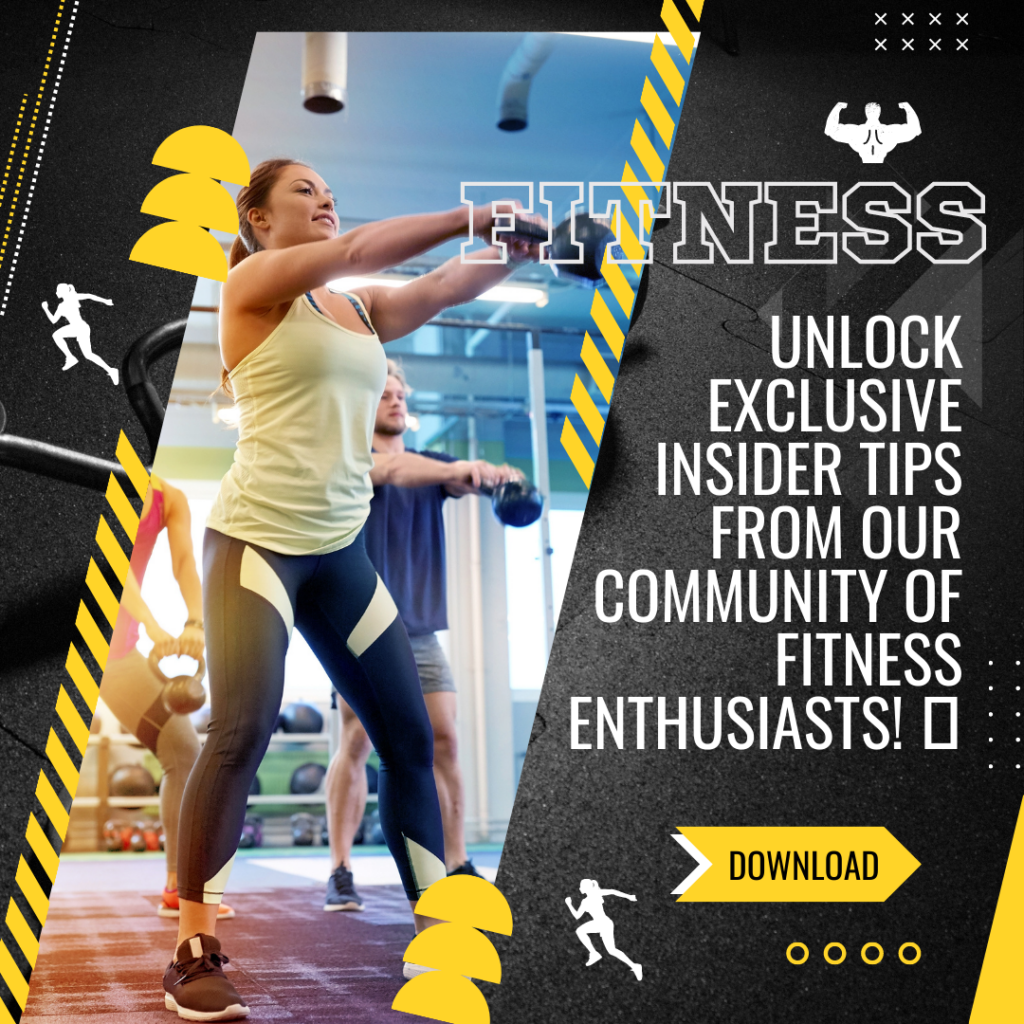
In this particular example, the paired text and image highlight the social prestige gained from joining a fitness enthusiast community. Initially, you craft an aura of exclusivity and elevated social standing by focusing on the invaluable advice and insider tips exchanged within the group. Subsequently, to boost engagement, you prompt a clear call-to-action, encouraging users to tag a friend and share their go-to fitness tips. This tactic not only fosters a robust sense of participation but also stimulates active interaction among audience members.
Moving forward, it’s crucial to adapt this template to suit your unique brand, specific target audience, and the dynamics of your community.
Ultimately, the aim is to emphasize the social value inherent in being part of a close-knit group, while simultaneously offering a platform for your audience to engage, share their expertise, and foster a sense of connection within the community.
Here is a tangible Example when using Social Sharing:
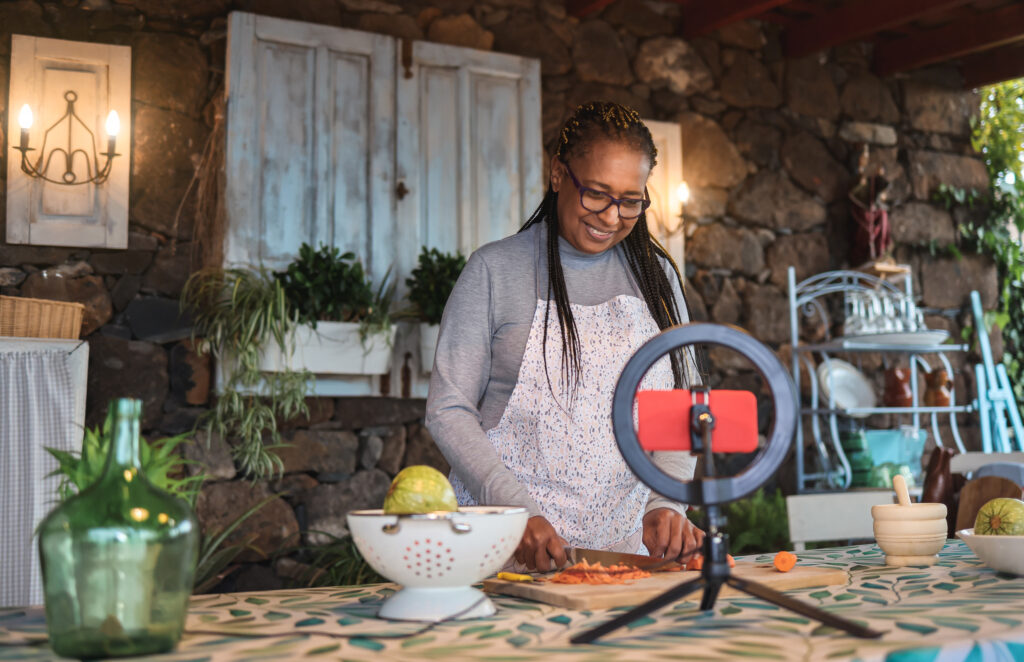
Consider a concrete example to underscore how social sharing catalyzes social engagement. Imagine a food blogger posts a mouthwatering, simple-to-prepare recipe on their blog. Enthusiastic readers who try and adore the recipe might subsequently share the blog post on their social media platforms, thereby boosting visibility and potentially attracting new followers.
As a result, social interaction escalates, sparking a ripple effect of shares, likes, and comments. This is, fundamentally, the strength of social sharing: it’s a tool that facilitates and amplifies social engagement.
By crafting valuable content that people are excited to share, you indirectly foster a wider conversation and interaction around your content, engendering a stronger sense of community and connectedness. Crucially, each social share functions as a personal endorsement, enhancing credibility and trust in your content. Therefore, leveraging social sharing effectively can significantly amplify your overall social engagement.
It’s Time To Have A Conversation!
Please share your thoughts about this topic in the comment section, and let’s discuss the following question. It would be awesome if you share your perspective so we can all learn and grasp new ideas.
- Have you ever shared a post that unexpectedly sparked considerable interaction or dialogue? What do you think made that post so shareable?
- In your experience, what kinds of content tend to generate the most shares, comments, and likes? Does this differ between various social media platforms?
- Have you noticed any common elements in posts that go viral or receive high levels of audience interaction? Do these elements influence your own content strategy?
- How has social sharing influenced the growth and community involvement on your own profiles? Can you share any success stories?
- What motivates you to share someone else’s content on your own profile? How do you decide what’s worth sharing with your audience?
- Do you have any strategies for encouraging your followers to share your posts? Have any techniques been particularly effective for boosting audience participation?
- How does the sharing of your content by others make you feel? Does it make you feel more connected to your audience or community online?
3. Emotions
Emotions are a powerful tool for triggering social engagement because they can evoke strong reactions and connect with people on a deeper level. When content evokes emotions, it tends to grab attention, foster connections, and encourage sharing. Here are five easy strategies to effectively use emotions to trigger social engagement:
By harnessing the power of stories, we can ignite emotions, fostering memorable experiences.
Incorporate narratives that hit home with your audience – personal tales, successful customers, or scenarios they can relate to.
Engage them through the art of storytelling, stirring up emotions like joy, empathy, or humor. This emotional bond can ignite your followers’ reactions, shares, or even personal tales.
Similarly, visuals can speak volumes, often sparking stronger emotional reactions. Incorporate eye-catching imagery, impactful videos, or expressive graphics that mirror the emotions you’re targeting with your message. Visuals, be they stunning photos, familiar memes, or heartwarming videos, tend to capture attention, stir emotions, and drive engagement.
Positivity is a powerful trigger. Emotions like joy, amusement, or awe often lead to more sharing and interaction. So share content that lights up these positive emotions through uplifting anecdotes, light-hearted content, or motivational quotes. Positivity can be infectious, pushing your audience to react, share, and join the conversation.
Empathy and relatability are key to forging connections. Address your audience’s struggles, aspirations, or common issues. Extend understanding, lend support, and provide solutions or encouragement. Showcasing empathy and relatability in your content can spur engagement, as your audience, feeling understood, may be inclined to share their experiences.
Lastly, create compelling headlines and captions that play on emotions. Use emotive words or phrases that invoke excitement, curiosity, urgency, or surprise. Experiment with various emotional triggers to pique interest and attract your audience to interact more with your content.
However, strive to maintain a balance with the emotions you evoke. They should align with your brand, values, and target audience.
Authenticity is essential in effectively using emotions to drive engagement. With these strategies, you can craft content that resonates, incites emotions and enhances social engagement.
Example:
Here’s an example of how to use emotion to trigger social engagement:
Caption: “Feel the warmth and joy of a genuine smile! 😊❤️”
Caption: “A smile is a universal language that spreads happiness wherever it goes. 😄💕 Tag someone with a smile that lights up the room, or share a moment that made you smile recently! Let’s fill the comments with positivity and spread the joy together! 🌟✨”
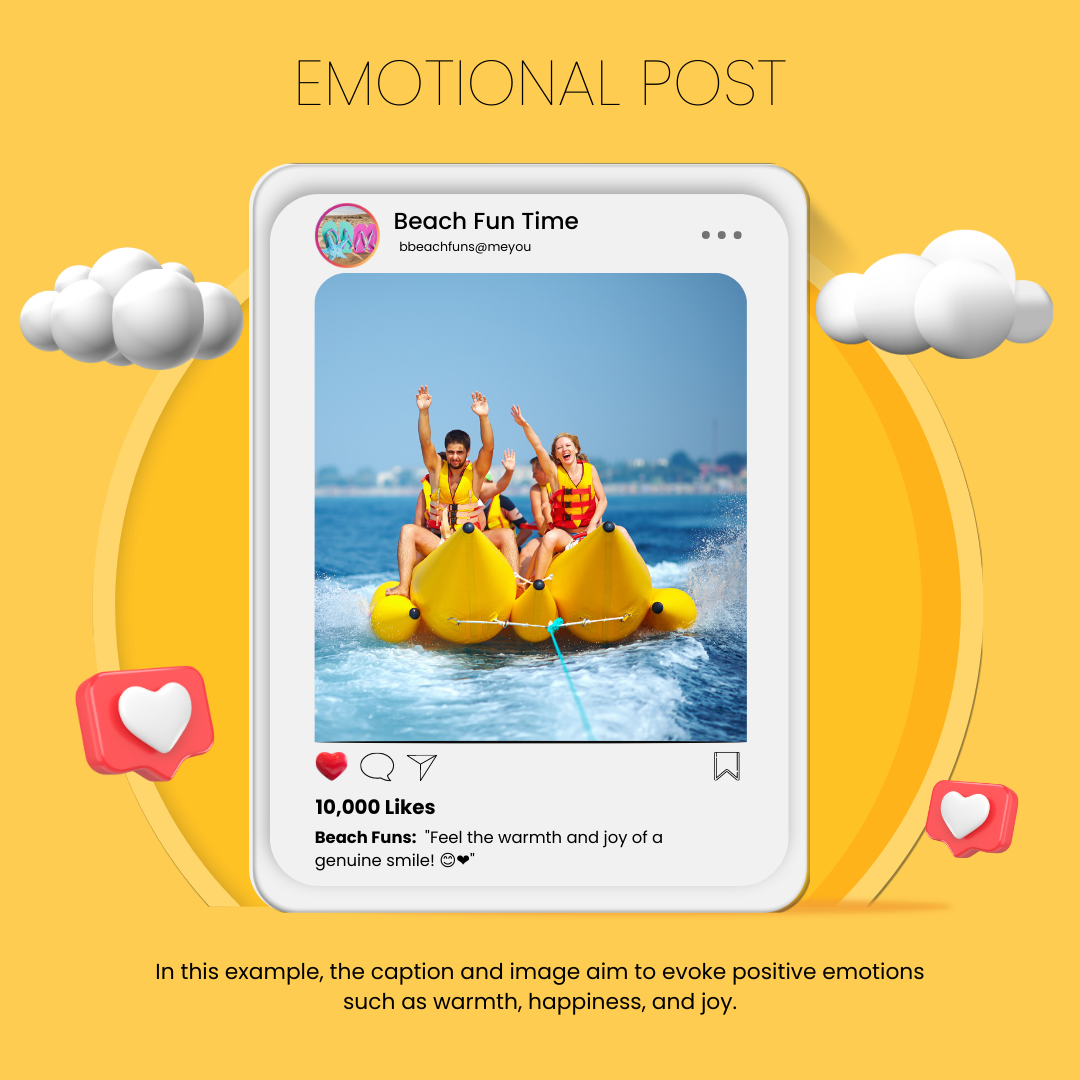
A smile is a powerful thing. It can brighten someone’s day, make them feel happy, and even improve their health. That’s why it’s a great way to improve social engagement on your social media channels.
To start, highlight the transformative power of a smile in your content. You can do this by sharing photos or videos of people smiling, or by writing about the benefits of smiling. Once you’ve captured your audience’s attention, invite them to engage with your content by tagging a friend with a captivating smile or sharing a personal moment that sparked joy. This is a great way to get people talking and interacting with your brand.
It’s important to tailor this strategy to your unique brand and target audience. For example, if you’re a business, you might focus on sharing photos of your employees smiling at work. Or, if you’re a personal brand, you might share photos of yourself smiling with your family and friends.
The goal is to create content that is both engaging and positive. When you do this, you’ll be well on your way to improving social engagement on your channels.
In-depth though about how Emotions work to increase social engagement:
Increasing social engagement often hinges on the ability to tap into the emotional core of your audience. Consider, for example, a non-profit organization aiming to raise awareness about environmental conservation. By crafting a powerful narrative around the heartbreaking effects of deforestation on wildlife – with gripping images and compelling stories – they stir feelings of empathy, sadness, and urgency among their followers. This emotional connection acts as a catalyst, prompting their audience to share the content, leave comments, and participate in discussions. This surge in interaction – a clear indicator of heightened social engagement – leads to a broader reach, potentially attracting new followers who are equally passionate about the cause. Emotions, therefore, serve as a potent tool for deepening the bond with your audience and driving engagement on social media platforms.
4. Usefulness
Usefulness refers to the content or information provided to the audience offering something that can positively impact their lives, solve a problem, or fulfill a need. Content with practical value provides tangible benefits, insights, or actionable advice that can be applied in real-life situations.
Here are five ways to increase social engagement for your business using practical value:
- Educational content: Share informative and educational content that teaches your audience something valuable about your industry or niche. This could include step-by-step guides, tips, tricks, tutorials, or how-to videos. By providing practical knowledge and skills, you can empower your audience and establish your brand as a trusted resource.
- Product demonstrations: Showcase the practical value of your products or services by demonstrating how they can be used effectively. This could include engaging videos, images, or testimonials. By highlighting the features, benefits, and unique selling points of your products or services, you can encourage your audience to learn more and take action.
- Problem-solving content: Identify common pain points or challenges your target audience faces and create content that offers practical solutions. This could include addressing their concerns, providing expert advice, or delivering actionable tips or strategies. By helping your audience overcome obstacles or achieve their goals, you can provide value and build trust.
- Case studies and success stories: Share real-life case studies or success stories that demonstrate the practical value of your products or services. This could include highlighting how your products or services have positively impacted your customers’ lives or businesses. By providing social proof, you can show your audience the practical benefits they can expect.
- Q&A sessions and live demonstrations: Host live question-and-answer sessions or live demonstrations where you directly engage with your audience and address their specific concerns or queries. This lets you provide practical solutions in real time and create a direct interaction that adds value and builds trust.
By following these strategies, you can use practical value to increase social engagement for your business.
Example:
Here’s an example of how to provide educational content to increase engagement:
Caption: “Master the Cake Decoration with These Essential Design Techniques! 📸✨”
Caption: “Calling all aspiring photographers! Enhance your skills and take your photography to the next level with these essential composition techniques. From the rule of thirds to leading lines, we’ve got you covered! 🌟”
Caption: “Swipe left to discover the techniques and comment below with your favorite composition tip or share an example of a photo you’ve taken using these techniques. Let’s inspire each other and create stunning visual stories together! 📷💡”
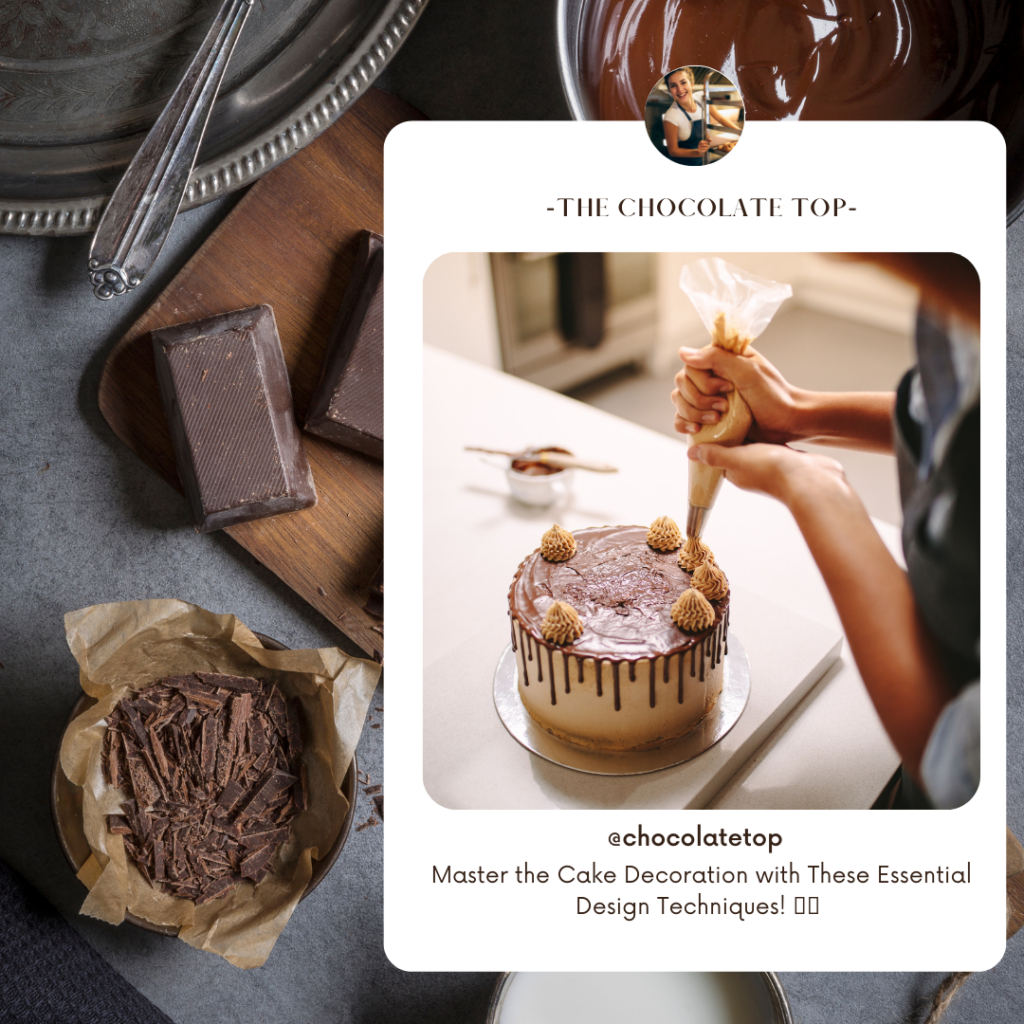
In the above example, check how to use educational content to increase social engagement on social media:
- Start by creating educational content that is tailored to your target audience. In this case, you could create a post that teaches aspiring photographers about essential composition techniques.
- Use visuals to make your content more engaging. For example, you could include an image of a well-composed photo along with your post.
- Ask questions to encourage interaction. You could ask your followers to share their favorite composition techniques or to post their own photos that demonstrate these techniques.
- Use a call-to-action to encourage participation. You could encourage your followers to comment on your post, share it with their friends, or tag someone who they think would be interested in the content.
By following these steps, you can create educational content that will engage your audience and help you to establish your brand as a trusted resource in your field.
Let’s take an in-depth approach to Usefulness!
Increasing social engagement often involves offering content that provides genuine value to your audience. Let’s consider a handmade jeweler who crafts unique pieces and sells them through social media. Beyond showcasing their beautiful creations, they might share ‘behind-the-scenes’ videos of their creative process, offer tips on jewelry maintenance, or write posts about the significance and history of certain gems and metals. This content is not only engaging but also beneficial to their followers. When a follower learns something new, such as the best way to clean their silver jewelry at home, they may share this useful tip with their friends, leave a thank you comment, or ‘like’ the post. Such interactions contribute to increased social engagement on the jeweler’s profile. Therefore, by embedding usefulness in your content, you can build a stronger rapport with your audience, spark meaningful conversations, and significantly boost your social media engagement.
Here are five questions to guide you in creating a usefulness-centered, socially engaging post:
- What common questions or challenges does my audience have that I could address in a post?
- What unique insights or expertise can I share that would be valuable to my audience and not easily found elsewhere?
- How can I present this useful information in an engaging, easy-to-understand format? Would a video, infographic, step-by-step guide, or another format be best?
- Is there a way I can invite my audience to interact with my post? Could I ask them to share their tips, experiences, or questions in the comments?
- How can I encourage my audience to share this useful content with others? Could I include a call to action inviting them to tag a friend who could benefit from the information?
Answering these questions can help you plan a post that offers useful information and encourages social engagement.
5. Share or Make Public
Simply put, “shared” refers to making things visible or observable to others. When applied to social media engagement, the public element involves creating content or interactions that can be seen by a wide audience, encouraging people to engage and participate. It’s about making your presence and activities noticeable to others. Here are five strategies to effectively use the “public” aspect to increase social engagement:
Here are some strategies you can use to increase social engagement:
- Create shareable content. Share content that is interesting, informative, or entertaining. This could include quotes, facts, infographics, or images. When people share your content, it exposes your brand to a wider audience.
- Use trending topics. Stay up-to-date on trending topics and join the conversation. Share your thoughts on these topics and offer valuable insights. This will help you to reach a wider audience and engage with potential customers.
- Engage in community discussions. Participate in discussions and conversations within your industry or niche. Respond to comments on your posts and leave thoughtful comments on the posts of others. This will show that you are an active member of the community and that you are interested in what others have to say.
- Run contests or challenges. Organize contests or challenges that require public participation. This is a great way to get people engaged with your brand and to generate excitement around your content.
- Collaborate with influencers. Partner with influencers or individuals who have a significant following in your industry. This is a great way to reach a wider audience and to generate more engagement for your content.
By following these strategies, you can increase social engagement and reach a wider audience.
Example:
Here’s an example of how to use the “Share” aspect of increasing social engagement:
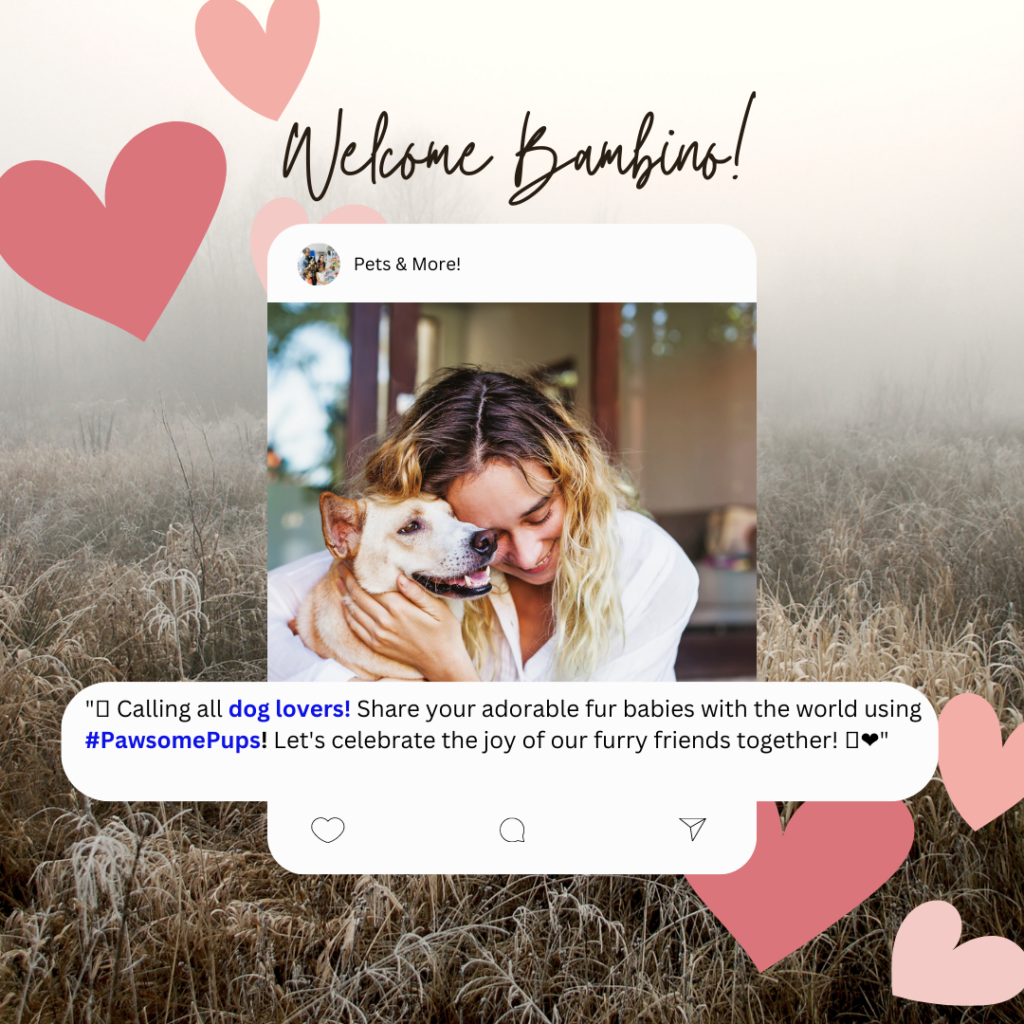
Caption: “

Caption: “It’s time to show off our beloved companions and spread puppy love! Join the #PawsomePups movement by sharing a photo or video of your four-legged friend using the hashtag. Let’s make our furry friends the stars of the show! 
Caption: “Tag a fellow dog lover who would appreciate the cuteness overload, or share a heartwarming story about your furry best friend in the comments below. Let’s build a community of dog enthusiasts and bask in the unconditional love they bring to our lives! 
In this example, the caption and image create a public platform for dog lovers to showcase their furry companions using the hashtag #PawsomePups. By inviting participants to share their dog photos or videos, you encourage them to make their furry friends’ cuteness public and engage with the content.
How to use a real-life situation using the strategy of sharing to help you increase your social media engagement
Let’s consider a restaurant owner who wants to boost social engagement on their business’s social media profiles. They decide to share a real-life situation: a night where everything in the kitchen went awry, from a burned batch of their signature dish to a power outage in the middle of dinner service. By sharing this story, along with photos or a video, they reveal a behind-the-scenes glimpse of the restaurant business that is rarely seen by customers. This openness and authenticity can create a stronger connection with their followers, who might comment with words of support, share similar experiences, or simply share the post with their friends because they found it engaging and relatable. This interaction can significantly bolster the restaurant’s social engagement. Furthermore, by making the public feel more connected and invested in the restaurant’s story, they are more likely to engage with future posts, thus cultivating a thriving online community.
Bonus: Strategies You Can Use Per Social Media

Instagram was created to be used on the phone and while traveling. Because of this, it emphasizes the value of straightforward content and graphics. The times matter here. You must create material that is easy to access, quick to read, enjoyable to watch, and memorable if you want to interact with your social media audience. Employ images, reels, carousels, quizzes, surveys, and brief videos to engage a target audience. Remember that your message must be tailored to your target audience to be effective. Use games, truth or dare material, AMA, quick “How to” videos, or humorous memes.
Here are 5 tactics that will also help when using Instagram:
Post regular, high-quality content that aligns with your target audience’s interests.
Use Relevant Hashtags: Research and incorporate relevant hashtags into your posts to increase discoverability.
Engage with Your Audience: Actively reply to their comments, ask questions, and show genuine interest in their opinions.
Explore Instagram Stories: Utilize Instagram Stories to share behind-the-scenes content, polls, quizzes, and interactive features.
Collaborate and Tag Others: Collaborate with influencers, industry experts, or complementary brands by featuring them in your posts or stories.
Example Questions You Should Keep In Mind When
“Instagraming”!
Am I Posting Enough?
Here are some key indicators to help you gauge if you’re posting enough, too much, or too little:
- Engagement Metrics: Monitor the engagement metrics on your posts, such as likes, comments, and shares.
- Audience Feedback: Pay attention to the feedback and comments you receive from your audience. If they express appreciation for your posts, request more content, or show excitement about your updates, it could suggest that you post at an appropriate frequency.
- Reach and Impressions: Track the reach and impressions of your posts. If you’re consistently reaching a high number of people and generating impressions even with a moderate posting frequency, it indicates that your content is resonating and reaching your audience effectively.
- Analytics and Insights: Utilize Instagram’s built-in analytics and insights tools to gain deeper insights into your audience’s behavior.
- Testing and Experimentation: Conduct experiments by adjusting your posting frequency and analyzing the results. Try posting more frequently for a certain period, then reduce or increase your frequency and observe how your audience responds.
Are My Hashtag Relevant?

Relevant hashtags are those that have a close connection to the subject matter of your Instagram post or the interests of your intended audience. They assist in classifying and organizing the platform’s material, making it simpler for users to find and interact with postings of interest. Here are some pointers for finding pertinent hashtags:
- Research: Use Instagram’s search function to explore hashtags relevant to your niche or industry.
- Competitor Analysis: Examine the hashtags your competitors or similar accounts in your field use.[Hashtagify.me, Rite Tag]
- Niche-Specific Hashtags: Find hashtags that are specific to your niche or the topic of your post.
- Trending Hashtags: Stay updated with trending topics, events, or holidays and incorporate relevant trending hashtags into your content.
- Hashtags with a Range of Popularity: Include a mix of popular and less popular hashtags in your posts. Using highly popular hashtags may increase visibility, but your post can quickly get buried in the sheer volume of content.
The following things should be taken into account when selecting hashtags:
Relevance: The hashtags you select should be appropriate for your target audience and the shared material.
Popularity: Your postings are more likely to be noticed by a larger audience if a hashtag is popular. However, overused hashtags should be avoided as they might not be as successful as more specialized ones.
Competition: Your content will be more difficult to stand out when there is more competition for a hashtag. Using less popular hashtags may be preferable if you’re just getting started.

How to engage with your audience?
Knowing your target market is the best and most important factor when engaging with your audience. You can spend hundreds of hours posting, but all those hours are lost if you don’t know your target market (your buyer). Check this article about defining your target audience.
Still, if you are still not sure about your target market but want to start engaging, here are an example of questions that can skyrocket your engagement:
- What’s your favorite [topic related to your brand or niche] and why?
- A great opportunity has been presented, and you can go to a specific location; where would you go?
- Write the most positive message you can share with us!
- What’s your go-to [product or service] that you can’t live without?
- Share one goal or aspiration you have for the upcoming year.
- What’s the most memorable book/movie/TV show you’ve experienced recently? Why did it leave an impact on you?
- What are those tiny things that are free but brighten your day?
- What make you feel comfortable or relaxed after a hard day or a bad experience?
- Please share a photo of something that brings you joy, and tell us why it’s unique.
- If you could learn something new, what would it be? It can be a skill or hobby, and why?
Facebook is a flexible social networking site that brings people together and promotes communication. It enables users to remain in touch with friends and family, connect with groups of people who share their interests, exchange personal information, and access various media. In addition, businesses can use Facebook for networking and promotion. Facebook also offers resources for planning events, accessing information, buying and selling goods, and contributing to various causes. Although Facebook has a wide range of functions, its primary strengths are its capacity to promote relationships, enable information sharing, and generate a sense of community among its members.

Here are 5 strategies you can use to engage with people on Facebook:
1. Facebook Groups: Create or participate in Facebook groups related to your niche or industry.
2. Live video broadcasts: Utilize Facebook Live to broadcast live videos and interact with your audience in real-time.
3. Storytelling: Share compelling stories that resonate with your audience. Whether it’s a personal anecdote, a customer success story, or a narrative related to your brand or cause, storytelling captivates users and fosters an emotional connection that encourages engagement.
5. Collaborations and partnerships: Collaborate with influencers, complementary businesses, or non-profit organizations to reach new audiences and create cross-promotion opportunities.

Pinterest is a visual bookmarking and helpful discovery tool for several things:
Inspiration and discovery: It is an excellent tool for igniting imagination and discovering new concepts.
Personal Organization: It’s a valuable tool for gathering and organizing concepts, articles, recipes, and other materials users want to refer to or try in the future.
Social Networking: Pinterest is a social media website that lets users share and find stuff to share with others.
Promoting Companies and Products: Pinterest presents a unique chance for companies, brands, and content producers to highlight their goods and services.
Benefits for SEO: Pinterest may help with search engine optimization (SEO). Pinterest pins may appear in search engine results, giving you another way to get organic traffic to your website.
Which are the best 5 tactics when using Pinterest for engagement?
Design Visually Appealing and High-Quality Pins:
Design eye-catching pins that attract attention and promote engagement. Use eye-catching photos, legible text overlays, and attractive artwork to make your pins stand out. As they function best on the platform, ensure your pins are vertical (with an aspect ratio of 2:3 or 1:2.1).
Use keyword optimization:
Since Pinterest functions as a search engine, filling your pins and boards with pertinent terms is important. Use tools like Pinterest Trends or third-party SEO tools for keyword research to find popular and pertinent phrases in your niche. Include these keywords in your pin descriptions, titles, and board names to improve discoverability.
Join and Participate in Group Boards:
A collaborative board where several people can pin information is called a group board. You may reach a larger audience and increase your exposure by signing up for relevant group boards in your niche. Be a productive contributor by posting insightful information, commenting on other users’ pins, and following the board’s guidelines. This raises awareness of and interest in your content.
Participate in the Pinterest Community:
Take an active part in the Pinterest community by pinning, commenting, and loving other users’ stuff. Follow accounts and boards that reflect your interests or the interests of your target market. You may get noticed, make relationships, and raise the possibility of reciprocated involvement by interacting with people and being a proactive member of the community.
Utilize Pinterest analytics to track the effectiveness of your pins and boards.
Analyze and adapt. Keep track of metrics like impressions, clicks, and saves to determine which material your audience responds to the most. Refine your content strategy based on these findings, produce more of what works, and change your plan to increase engagement.
YouTube
YouTube is another big giant of social media. It can be very intimidating if you fear the lens or feel uncomfortable in front of a camera. Not anymore; you can do your videos without showing your face. Use animation, voice-over images, PowerPoint, only your hands, only your voice; the solutions are there; you need to pick the most comfortable to engage with your social media audience. YouTube is to entertain a large public in less than 13 minutes; that is the most significant clue! You can use it for lectures, demonstrations, and promotion; the list goes on and on.

Consider putting the following tactics into practice to increase interaction on YouTube and inspire viewers to participate with your content:
Make Interesting Videos:
Create fun and exciting videos that others enjoy watching. Show your creativity, share your hobbies, or teach something you’re passionate about. Consider what makes people curious and want to click on your video.
Use Cool Thumbnails and Titles:
Design eye-catching pictures and titles for your videos. Use colorful and exciting images that represent your video well. Ensure the title is clear and tells people what to expect from your video.
Ask for Likes and Comments:
Encourage your viewers to like and comment on your videos. Ask them questions or ask for their opinions. For example, at the end of your video, say something like, “I would love to hear what you think, so leave a comment below!”
Respond to Comments:
When people comment on your videos, make sure to respond to them. Show that you appreciate their thoughts and take the time to have conversations with your viewers. It’s a great way to make new friends and keep people engaged with your channel.
Tell Others About Your Channel:
Let your friends, family, and classmates know about your YouTube channel. Share your videos with them and ask for their support. They can like, comment, and share your videos with others, which helps you reach more people.
Collaborate with Friends:
You can collaborate with your friends on YouTube channels and make videos together. This way, you can cross-promote each other’s channels and introduce your audiences to new content. It’s a fun way to work together and attract more viewers.

Twitter is great for social news or networking. It is considered microblogging. You have a vast audience, but you need to get followers first because people will only react to your tweets with people following you. The best way to engage with people on Twitter is by following others with a good ratio, keeping conversations, exposing controversial topics, tweeting regularly, using hashtags, maintaining a great profile with a picture, and staying on top of trendy topics. On Twitter, the primary way to get followers is through active participation.
Here are five simple tactics to use on Twitter:
Use Hashtags:
Hashtags are like labels that help people find tweets about specific topics. Use relevant hashtags in your tweets to reach more people who are interested in those topics. For example, if you’re talking about cooking, you can use hashtags like #recipes or #foodie.
Engage with Others:
Interact with others on Twitter by liking, retweeting, and replying to their tweets. Show that you’re interested in what they say and start conversations with them. It’s like making new friends and talking to them online.
Share Helpful Content:
Share valuable and exciting things in your tweets. It could be tips, news, or something you find cool. When you share valuable content, people will like, retweet, and follow you because they appreciate what you share.
Join Twitter Chats:
Twitter chats are like group discussions on specific topics. You can join these chats by using a unique hashtag at a specific time. It’s a fun way to talk to others who are interested in the same things as you. Just make sure to use the hashtag so everyone can see your tweets.
Add Pictures or Videos:
Include pictures or videos in your tweets to make them more interesting. It’s like adding a fun visual element to your message. People are more likely to notice and engage with tweets that have cool pictures or videos.
TikTok
TikTok’s primary purpose is to make short videos. TikTok initially gained the heart of young people, but after Covid19, more adults are using the app, shortening the population gap. It is the best venue to express themselves through singing, comedy, dancing, short imitations, dares, lip-singing, or creative expressions. It means that to engage in TikTok, you need to make your game plan in detail. First, you have 3 seconds to get the attention of the audience. Second, the content needs to be funny, intriguing, or tell a story.
Here are five additional unique methods for companies to interact with customers on TikTok:
Display Behind-the-Scenes Content:
You may give your audience an inside peek at your company by presenting behind-the-scenes material. Introduce your staff, describe how your items are manufactured, or provide sneak peeks at planned initiatives. This helps your audience feel more connected to your business and gives them authenticity.
Campaigns for User-Generated Content:
- Encourage the creation of content for your brand or items by your fans.
- Run campaigns or competitions for user-generated material where participants may show off their creativity.
- Ask people to make movies utilizing your product, for instance, or to express their impressions of your company.
This sparks interest, boosts participation, and offers social proof.
Working with Influencers
Partner with industry influencers who have a sizable TikTok following. Join forces to create sponsored videos, product reviews, or co-created content. Influencers may help your company gain a reputation, expand its audience, and raise brand recognition. Pick influencers whose audience closely matches your target market for the most significant impact.

How-To and Educational Content:
- Share informational or instructive materials about your field or specialty.
- Make tutorials, how-to videos, and other valuable content for your audience. As users gain knowledge from your material, this establishes your company as an authority and promotes engagement.
- Encourage viewers to submit queries or topic requests for upcoming videos.
Take Part in Common Challenges and Hashtags:
Keep up with everyday challenges and hashtags pertinent to your business or sector. Create videos that fit the theme or concept to participate in these trends. This enables you to participate in discussions, reach a larger audience, and raise the likelihood that people will find and share your material.
Emails
Collect and use your user emails; it is the best way to connect with people. Promote your new posts or blog. Maintaining communication with your users facilitates engagement. Email empowers your site, giving you a great conversion rate. Not everyone is ready to share emails, so exchanging information is best.
In other words, you give me something, and I provide you with something else. For centuries the actions of exchange have worked! Now that you have the emails is time to work on that conversion rate.
Get Your Team Ready with Social Media Management
Have you ever thought about asking for help from a social manager? Social managers are a great tool to keep your site fresh and revised, but they are even better at helping you engage with your social media audience. Owning a new site means you must periodically verify the content you have on your page. Google is a search engine, so its vital job is to give users the best information available. If someone visits your page and finds the information outdated or irrelevant to the search, the user leaves the site and proposes another search. The time and users spend on your site tells Google the information you have is engaging, has value, and deserves for the site to have a better rank. So, next time think of a social media manager to keep your engagement rolling.

Conclusion:
Social interaction is a crucial component of any effective online approach. Top influencers successfully employ the five social engagement tactics highlighted in this blog.
These strategies provide insightful tips for optimizing your social media presence, regardless of whether you’re a budding influencer, digital marketer, or business owner. Remember that the ultimate goal is establishing genuine connections that encourage engagement and loyalty.
It’s crucial to remember that, despite the fact that these tactics have been tested, there is no one-size-fits-all strategy for achieving success on social media. What is effective for one influencer or brand may not be effective for another. Testing, learning, and modifying while using these suggestions as a springboard is the best course of action.
The capacity to stay up with and adjust to these social media developments sets effective influencers and business people apart from the competition. Therefore, never undervalue the potential of engaging your audience, and always be curious and learning. By implementing these tactics, you’ll be well on your way to improving your online presence and establishing long-term social media success.




